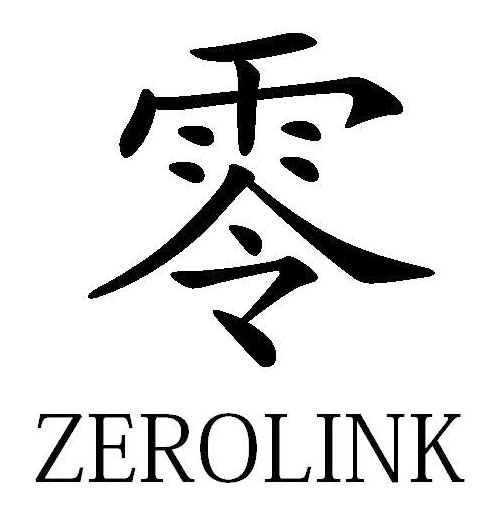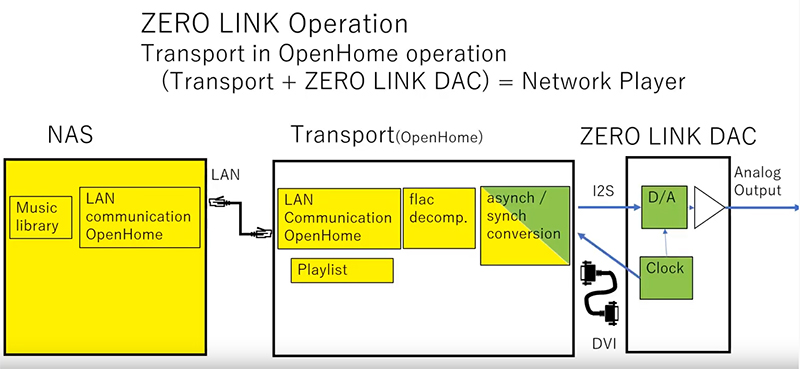
It is believed that digital performance can never rich the quality of a good analog source — yes until you listen to Sforzato with ZERO LINK!
Digital Network Audio is a special area of technical art, where completely different areas of knowledge come into contact — computer network technologies and classic analog audio. And to achieve the real quality of music performance, one must finely feel these dependencies and spend a lot of time on technical and empirical studies of these complex patterns. Sforzato and its leader Kyoichi Omata take this approach to develop their unique products and offer only those that provide uncompromising musical and sound quality.
It was only as a result of the true pursuit of the ideal of digital musical performance that the idea of ZERO LINK, a joint development of Sforzato and SoulNote, was born. This is not just a special connection between two digital devices — this is the only way to get absolute digital performance!
The main idea of ZERO LINK is very simple and is that you don't have to do anything extra! This is a guarantee of quality music and sound. This may seem to be the opposite of the current “technocratic” trend that high sound quality can be achieved through improvements in technical aspects such as oversampling, PLL, etc.
ZERO LINK is the new digital signal transmission method developed by Japanese companies Sforzato and SoulNote. The key of ZERO LINK is that the Master Clock is the DAC, not the Transport as usual.
The main purpose of the ZERO LINK connection between the transport and the DAC is to eliminate anything that runs asynchronously with the DAC clock and that is a source of noise for the DAC, which runs in sync with the D/A conversion clock.
Sforzato has been developing network players for over 12 years, and in 2019 introduced a new LAN DAC function by creating new firmware. Research has shown that the same network player provides better sound quality in LAN DAC mode than in network player mode.
What is the reason for the difference in sound quality?
The work of any DAC is the serial conversion of digital data into an analog signal in accordance with the sampling frequency of the converted signal. This frequency must be kept very stable by the clock, and even a slight deviation will directly result in a noticeable deterioration in sound quality.
Network Player Mode
In Network Player mode, the player receives audio data from the NAS and decompresses on its own. It receives data in packets and temporarily stores them in internal memory. From there, the data is gradually converted to an analog signal. As soon as the buffer is empty, the next data packet arrives from the NAS. This is repeated many times.
In addition, the player periodically reports the elapsed time and other data to the controller. Also, the network player must display a lot of additional information on the display, such as album title, artist, time, etc. Also, the player has to do a lot of additional work besides the main task of digital-to-analog conversion.
In the network mode, the busy CPU depends on the time. When getting data from the NAS, a network player is very busy. After receiving data, the processor is relatively free, but when the buffer is close to empty, the processor is heavily loaded again.
The data sent from the NAS to the DAC via USB or LAN arrives at a completely different rhythm than the rhythm of the D/A conversion. A certain amount of data is sent in blocks, which must be arranged so that the DAC can read them according to its own rhythm. The work of receiving and arranging data is also done with different timing than the D/A conversion.
Imagine that you are beating a drum in a certain rhythm, and next to you someone else is beating loudly in a completely different rhythm. What music can be there at all? This is a very significant hindrance to an accurate D/A conversion.
LAN DAC Mode
In LAN DAC mode, the player only needs to receive a data packet from the NAS, decompress it, and convert data to the analog signal.
Data is also sent as a packet, but the packet size (amount of data per packet) is smaller than in network mode, and packets are sent more frequently, so the processor load is relatively constant.
Sforzato and SoulNote believe that this difference (the amount of additional work for the processor and the uniformity of its load) is the reason for the improvement in sound quality in LAN DAC mode. In this way, you can reduce the additional processor load to zero and bring the fluctuations in the processor workload to zero as well!
This solution is ZERO LINK!
ZERO LINK Operation
The part of the DAC connected to the transport via ZERO LINK completely eliminates problem of processor loading and fluctuations in its workload. In this case, the extra work of the DAC is reduced to zero.
The I2S signal is the input for the DAC chip. It can be directly fed into the DAC. For DAC, there is no additional work — zero. The I2S data sent from the NAS, which is synchronized with the DAC’s Master Clock, represents an absolutely constant, non‐fluctuating workload for the DAC.

The track format information from the Transport is passed to the DAC, after which the DAC sends the frequency corresponding to the track format to the Transport. The Transport then incrementally (once per clock cycle) sends the data to the DAC in chunks. As a result, there is no noise and deviations inside the DAC — only one clock frequency, which allows you to get high‐precision digital‐to‐analog conversion without disturbing the rhythm.
This is the ZERO LINK mechanism at work — the ultimate solution for transferring digital data from Transport to DAC.
Kinds of connections used by ZERO LINK
There is nothing special about ZERO LINK’s internal communication. It is a combination of existing technologies. Basically, it is I2S and I2C communication. Both are standard communication methods for the chips inside the player, which are almost always used in digital audio equipment. I2C is used between ICs to tell each other to change settings. I2S is a standard means for inputting music data into a DAC chip. However, in this method, the Transport side is essentially the Master Clock.
ZERO LINK is the means of using the DAC as a synchronization master when sending music data from the Transport to the DAC over I2S. In the place where the DAC has a Master Clock, there is its own device. As you know, the importance of the Master Clock lies in the fact that the conversion of digital data to analog occurs with an accurate and constant rhythm inside the DAC. This rhythm with the sample rate sets the Master Clock.
The quality of the DA conversion directly depends on the accuracy and stability of synchronization. If the clock on the Transport side is leading, it determines the rhythm. The clock pulses are fed from the Transport to the DAC, and it performs a digital‐to‐analog conversion in accordance with these clock pulses.
If the DAC is the Master, then clock pulses are sent from the DAC to the Transport, and data is sent from the Transport to the DAC at the same rhythm. The DAC can do digital‐to‐analog conversion with clock pulses inside it. It is difficult to achieve sound quality if you leave the Clock in Transport and provide it with remote control. In this sense, it is extremely important for the sound quality that the DAC be the Master Clock!
However, there is one problem here. Some tracks are 44.1kHz, some are 192kHz, and some are DSD. As long as the DAC is the Master, it must send clock pulses to the Transport that correspond to the format of each track. But DAC doesn’t know what track will play next. This makes it impossible to send sync pulses to the Transport at the sample rate of the track in time.
This is where ZERO LINK comes in, which uses I2C to send track format information from the Transport to the DAC at the end of the previous track to confirm that the clock that matches the track’s frequency has been sent, and then the next track is played.
ZERO LINK establishes new rules for the exchange of clock pulses between Transport and DAC. This allows the DAC to use the Master Clock without worrying about the format of the track being played. Music data over I2S via ZERO LINK is sent to the DAC chip as is. Data is received from the Transport according to the Master Clock rhythm, and digital‐to‐analog conversion inside the DAC also takes place according to the same rhythm.
Of course, not everything is as simple in Sforzato equipment as it might seem at first glance. There are many tricks to get the best sound quality, but this is proprietary know‐how that cannot be made public.
The implementation of ZERO LINK is possible only when the Transport and DAC are separated.
The essence of ZERO LINK is to exclude from the DAC everything that breaks the rhythm of digital‐to‐analog conversion.
No matter how much the internal communication inside the player matches up with ZERO LINK, and the board and power supply are separated, there is a big difference in the impact on D/A conversion between a DAC, that coexists with the asynchronous operation and a DAC that operates in full synchronous mode. Therefore, the DAC and Transport chassis must be separated to eliminate all circuits, that operate asynchronously with the DAC’s Master Clock.
No matter how sophisticated USB or LAN usage patterns are, the factors that break the rhythm of digital‐to‐analog conversion simply cannot be eliminated. Ideally, the DAC should receive the music data sent from the Transport in a way that doesn’t break the internal rhythm of the digital‐to‐analog conversion — and that method is ZERO LINK.
It’s also important not to confuse ZERO LINK with Diretta.
Diretta is a general‐purpose LAN network protocol, while ZERO LINK is an interface designed for Transport and DAC communication.
Diretta minimizes the extra workload and fluctuations on the DAC and also delivers improved sound quality. However, this is LAN communication and is also asynchronous to the DAC’s digital‐to‐analog conversion. To completely eliminate asynchronous operation in the DAC, it is necessary to separate the LAN/USB connection from the DAC.
Mono DAC is another interesting feature of ZERO LINK.
With ZERO LINK you can realize the highest level of DA conversion available today, using a Mono DAC function.
In this case, two identical DACs (left and right) will be absolutely synchronized, but for this, it is necessary to set two identical Master Clocks for each channel.
Sforzato has been engineered to switch between stereo and mono modes, allowing you to enjoy unprecedented sound quality in the future. Sforzato DACs have two ESS–9038PRO chips running in stereo mode, one per channel, but if you use mono mode, then two ESS–9038PRO chips will work both on the same channel.
Current SFORZATO players/DACs do not support mono mode. Sforzato is planning to make transport with dual ZERO LINK output and mono DAC in 2023. It might be the original discrete DAC.

